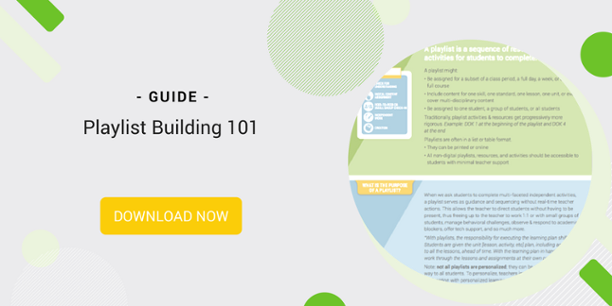
how to pick the right instructional model for your classroom
personalized learning | classrooms
selecting the right instructional model to personalize learning is a bit like cooking dinner for my family. it’s an art, not a science. to better understand this analogy, it is important to be familiar with the three base models that teachers have in their proverbial pantry: station rotation, playlists, and flipped lessons. to learn more about each of these in the elementary and secondary settings, check out these infographics: pl models for elementary classrooms & pl models for secondary classrooms. let’s first explore where each model is most useful:
station rotation |
playlist |
flipped lesson |
|
ideal for:
|
teachers:
content/activities:
students:
|
teachers:
content/activities:
students:
|
teachers:
content/activities:
students:
|
|
not ideal for:
|
content/activities:
classes:
|
content/activities:
classes:
|
content/activities:
classes:
|
i like to think of the three instructional models as the key ingredients in my personalized learning pantry. each ingredient is lovely on its own; however, the magic happens when i strategically blend them to create a delicious dish. i also always add seasoning and spice to enhance my ingredients; teachers do the same thing by layering elements of the core four into their instructional model.

so, how does this model blending and layering work in the classroom? it happens everyday, in fact. these are not static decisions made once per year. teachers pick instructional models and personalized learning tactics for each and every lesson.
- consider your content: which instructional model might it pair well with this content? do i plan to differentiate content based on student interests or needs? was this content tricky/engaging/boring for my students last year? what resources do i already have?
- consider your students: are there gaps in some students’ foundational knowledge of this topic i should consider? which core four element(s) am i focused on right now? do i want all of my students to learn the same content at the same time? would my students benefit from time in a teacher-led small group?
let me show you the end result of this process by serving up a few classroom recipes:



how can you get started in your personalized learning ‘kitchen’? start with a self-assessment: should you sample the key ingredients (station rotation, playlist, & flipped lesson) first to get a sense of what your personal tastes are, or are you ready to layer & experiment? when i started cooking, i prefered a prescribed, recipe-driven approach, but i quickly evolved to a more “what ingredients do i already have on hand?” strategy. just like cooking, designing a personalized lesson is rarely perfect, and you will probably tweak the recipe each time. the moral of the story is to start wherever feels comfortable for you and your students.



